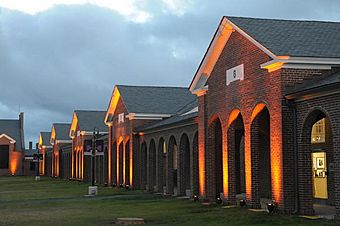Workhouse Arts Center facts for kids
The Workhouse Arts Center in Lorton, Virginia is a lively place for art and learning. It covers 55 acres and uses old buildings from a former prison called the Lorton Reformatory. This center is a big part of the community. It hosts fun events and shows how much Fairfax County cares about the arts. The Workhouse is a non-profit group, which means it relies on help from its partners and the community.
This place was once surrounded by fences. Now, it celebrates art and welcomes everyone. Artists rent spaces to create their work. Actors perform on stage. Students of all ages can take classes, from dance to blacksmithing. The campus has beautiful arched walkways. It was designed like the University of Virginia. Popular events include a Fourth of July fireworks show, a Brewfest, and a Halloween "Haunt." A new addition is the Lucy Burns Museum. It shares the 91-year story of the old prison. It also honors the brave women who were held there in 1917. These women were fighting for women's right to vote.
Contents
Discovering Arts and Learning at the Workhouse
Buildings that once held prisoners are now bright art studios. More than 80 artists work here. Visitors can walk through these buildings. They can see the art and even buy it. You can also talk to the artists. Artists create many types of art. This includes painting, drawing, ceramics, and photography. They also work with glass, metal, and fabric. The buildings are open to everyone from Wednesday to Sunday. On the second Saturday of each month, there is a special "Art Walk" party.
Creative Classes for All Ages
The Workhouse has many classrooms. You can learn different visual arts here. There are also classes for dance styles. You can try exercise methods like yoga and Pilates. Cooking classes happen in a special kitchen. You can also take music lessons for piano, voice, cello, and flute. Students of all skill levels come to learn at the Workhouse.
Enjoying Live Performances
The Workhouse Theater puts on four plays each year. They get great reviews! Their shows include popular musicals and modern plays. Comedy nights and musical shows happen regularly. During the summer, music performances take place every Saturday evening outdoors. Ballroom dancing is also a popular event. It happens on some weekends in one of the main galleries.
The Lucy Burns Museum: A Story of Courage
In 1917, women stood outside the White House. They were asking for the right to vote. Many were arrested and sent to the Women’s Workhouse. The museum is named after Lucy Burns. She helped start the National Woman’s Party. She was arrested more than any other suffragist in the United States. During a terrible event in November, 32 women were treated very badly. This event was called the "Night of Terror." Some women, including Lucy Burns, refused to eat. They were protesting their treatment. Their jailers then forced them to eat.
After they were set free, the women shared their stories. People across the country were very angry. This anger helped lead to the 19th Amendment. This amendment gave women the right to vote.
The museum also tells the interesting story of the prison itself. It even includes some of the old prison cells. These cells were added in the 1960s. The museum is open from 11 AM to 6 PM, Wednesday to Sunday.
Workhouse History: From Prison to Art Center
At the start of the 1900s, the prison in Washington, D.C., was too full and dirty. President Theodore Roosevelt wanted to improve prisons. He asked a group to study the problem. They found that prisoners could learn skills instead of doing nothing. This would help them in the future. It would also help local communities. The idea of a "Workhouse" gained support. Congress agreed to buy 1,155 acres of land in Virginia. The Workhouse was meant to help prisoners improve. It offered fresh air, good food, honest work, and fair treatment. The first prisoners arrived in 1910. They were put to work right away. First, they built wooden buildings from trees on the land. Then, they made a brick kiln. Using local clay, the prisoners built the permanent brick dorms.
Once the buildings were done, the Workhouse focused on farming. It aimed to be self-supporting. The Workhouse grew to include farms, pastures, and an orchard. It had a cannery, a poultry farm, and a hog ranch. There was also a slaughterhouse, a dairy, and a blacksmith shop. A sawmill processed timber. There were also barns for feed and storage.
The prison complex grew to over 3,200 acres. But by the late 1980s, the prison had problems. It was too crowded and disorganized. This led to protests, riots, and fires. It was no longer helping prisoners as planned. A federal law forced the prison to close. The last prisoner left in 2001.
Fairfax County bought 2,324 acres for $4.2 million in 2002. They started to turn the old prison into an arts center. Two years later, the county approved changing the use of 55 acres. This included the original Workhouse buildings. These buildings were designed in a special style with columns. This area became the Workhouse Arts Center.
Today, Fairfax County still owns the land. The Workhouse Arts Foundation Inc. rents the property. They work with the county to provide cultural and educational benefits to the community. The Workhouse Arts Center opened to the public in 2008.
Images for kids



